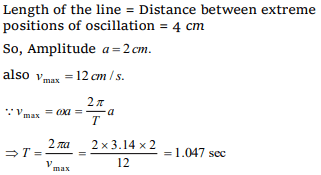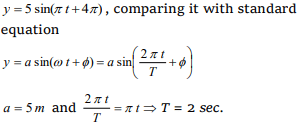1. What is constant in S.H.M
a) Restoring force
b) Kinetic energy
c) Potential energy
d) Periodic time
Explanation: Periodic time
2.If a simple harmonic oscillator has got a
displacement of 0.02 m and acceleration equal to 2.0 m \[s^{-2}\] at any time, the angular frequency of the
oscillator is equal to
a) 10 rad \[s^{-1}\]
b) 0.1 rad \[s^{-1}\]
c) 100 rad \[s^{-1}\]
d) 1 rad \[s^{-1}\]
Explanation:

3.The equation of a simple harmonic motion is \[x=0.34\cos\left(3000 t+0.74\right)\] where X and t are in mm
and sec. The frequency of motion is
a) 3000
b) \[3000/2\pi\]
c) \[0.74/2\pi\]
d) \[3000/\pi\]
Explanation:

4. Mark the wrong statement
a) All S.H.M.’s have fixed time period
b) All motion having same time period are S.H.M
c) In S.H.M. total energy is proportional to
square of amplitude
d) Phase constant of S.H.M. depends upon initial
conditions
Explanation: All motion having same time period are S.H.M
5. A particle in SHM is described by the
displacement equation \[x\left(t\right)=A\cos\left(\omega t+\theta\right)\]
. If the
initial (t = 0) position of the particle is 1 cm and
its initial velocity is \[\pi\] cm/s, what is its amplitude? The angular frequency of the particle
is \[\pi\] \[s^{-1}\]
a) 1 cm
b) \[\sqrt{2}cm\]
c) 2 cm
d) 2.5 cm
Explanation:

6. A particle executes SHM in a line 4 cm long. Its
velocity when passing through the centre of line
is 12 cm/s. The period will be
a) 2.047 s
b) 1.047 s
c) 3.047 s
d) 0.047 s
Explanation:

7.The displacement x (in metre) of a particle in,
simple harmonic motion is related to time t (in
seconds) as \[x=0.01\cos\left(\pi t+\frac{\pi}{4}\right)\]
The frequency of the motion will be
a) 0.5 HZ
b) 1.0 Hz
c) \[\frac{\pi}{2} HZ\]
d) \[\pi HZ\]
Explanation:

8. A simple harmonic wave having an amplitude a
and time period T is represented by the equation \[y=5\sin\pi\left(t+4\right)m\] . Then the value of amplitude (a) in
(m) and time period (T) in second are
a) \[a = 10, T = 2\]
b) \[a = 5, T = 1\]
c) \[a = 10, T = 1\]
d) \[a = 5, T = 2\]
Explanation:

9. A particle executing simple harmonic motion of
amplitude 5 cm has maximum speed of 31.4 cm/s.
The frequency of its oscillation is
a) 3 Hz
b) 2 Hz
c) 4 Hz
d) 1 Hz
Explanation:

10. The displacement x (in metres) of a particle
performing simple harmonic motion is related to
time t (in seconds) as \[x = 0.05\cos\left(4\pi t+\frac{\pi}{4}\right)\] . The
frequency of the motion will be
a) 0.5 Hz
b) 1.0 Hz
c) 1.5 Hz
d) 2.0 Hz
Explanation:
